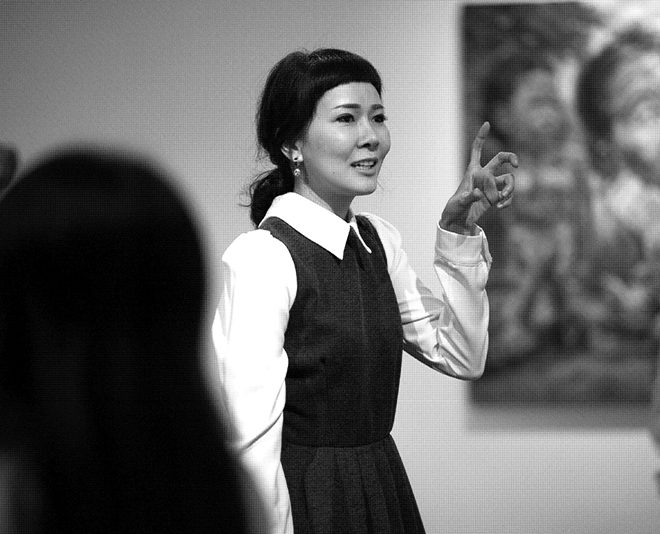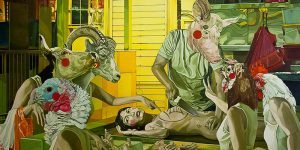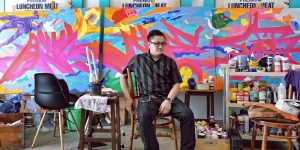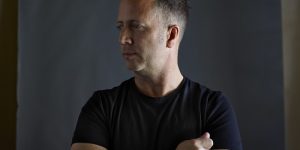Interview: Artist Lampu Kansanoh
Her caricatures capture daily life in a comical vivd and unusual way. We speak to the artist and learn more about her work.

Born in Samutsongkhram, Thailand, Lampu Kansanoh is a Thai painter and sculptor who currently lives and works in Bangkok. She graduated with a Bachelor and Master of Fine Arts from Silpakorn University in Bangkok.
In 2012, she was an artist in residence at the Fukuoka Asian Art Museum, which culminated in the ‘Winds of Artist’ exhibition in November in the same year. In Singapore, she had her first solo exhibition, ‘Love Untitled’ at Valentine Willie Fine Art in October 2011, and ‘Nah, Just A Stopover’ at Yavuz Gallery in December 2013. Back home in Thailand, her works have been exhibited widely, including three solo exhibitions at Ardel Gallery of Modern Art, ‘Nonsense: No-nonsense’, ‘Bitter Sweet’ and ‘Global Warming’ in 2009, 2011 and 2013 respectively.
Lampu’s paintings are vibrantly colored vignettes of everyday life featuring caricature-style figures with expressive faces. Her sculptures feature similar bobble-head characters in bronze. Her work draws from her personal relationships as well as her thoughts about socio-political situations in Thailand.
When and how did you decide to become an artist? What have been your most significant successes and challenges to date?
I decided to become an artist when I was in high school. I was 15-years-old and I realized that painting was the thing that I did best. I did not even really like to paint then. I was inspired by the talents of my classmates and decided to work really hard at painting; when the teacher assigned one painting, I would paint two or three.
It was at Silkpakorn University that I fell in love with painting and decided to major in it. My neighbors told me that no one could be an artist in Thailand. They said it was too hard to making a living from it, and that my dream was not realistic. This was my biggest challenge but also my biggest success: when I became a successful artist even though no one believed it was possible.
How has your work evolved? What changes your work from piece to piece?
My work evolves with each series and reflects my experiences and what happens in my life. For example, when my mom died, my paintings focused on my love for her. Now that I am getting married, my work reflects my love and appreciation for my fiancé. And my work has also shown my feelings about the political situation in Thailand.
What is your daily routine as an artist? Do you have a fixed structure to the way you work?
In a year, I usually prepare for two exhibitions. Each exhibition requires three months of intense preparation. During this time, I try to work every day. I usually wake up at 7am and work from 9am to 5pm. I try to complete each painting in four to five days.
You appear to portray everyday life in your paintings. How do you compose each painting? Do you sit and sketch while observing a scene in real time or do you put a tableau together from memory and/or imagination?
First, I roughly sketch an idea and write about my ideas for the subject of the painting. I then photograph the model with the desired facial expression and position for the painting. And after I base more sketches and eventually the final painting on the photographs.
What are you trying to express in your artworks with regard to Thai society, and more broadly the human condition?
In my paintings, I try to show joy and happiness in unexpected places. In 2011, I went to Ayuthaya where there was a lot of flooding. Many people had lost their homes and it was a terrible situation, but I could still feel their optimism despite their circumstances.
What comes first: the titles of your paintings or the paintings themselves? How do the titles, such as ‘What Happens on the Subway!!!’ (2015) or ‘Oh My Goodness!’ (2013) work together with your paintings to communicate with the audience?
Sometimes I have an idea first, and at other times, the title comes first. It depends. When I was in New York, I encountered a ‘No Pants Subway Ride’, where many people were not wearing pants on the train. The title ‘What Happens on the Subway!!!’ is a question that I am asking the audience. It is my reaction to this strange experience, and I want the audience to guess what has happened from the painting.
In ‘Oh My Goodness!’, I only show the ladyboy’s back as she is lifting her shirt and the soldier’s facial reaction to the ladyboy’s sex change. This painting is a joke, because the ladyboy is blatantly proving that she is not required to join the military. She is shocking the soldier and proving that she has changed her gender. Here, the title is the soldier’s reaction.
Both your paintings and sculptures feature characters with large-sized heads. How did this signature style come about?
When I was a third-year university student, I looked at my friends’ faces; I saw a dichotomy between how old or scary they looked and how beautiful and innocent their spirits were. I had an idea to paint their faces on plastic in pastels and with cute childlike patterns, and decided to paint the faces of my friends with babies’ bodies; babies’ heads are often too big for their bodies, so this was why I chose this scale. I have continued to paint in this fun and playful caricature style where the heads are oversized because I can communicate more to the audience with more room to portray facial expressions as well.
Your artworks have been placed in auctions with international auction houses Christie’s and Sotheby’s. What does it mean to you to be an ‘auction house artist’?
I appreciate the success and at times I cannot really believe it too. But for my work as an artist, it does not really change anything.
Based on your own experience as an artist, what advice would you give to young artists just starting out?
Keep doing what you want to do, even if people tell you that you will not get anywhere.
Story Credits
Text by Nadya Wang
This story first appeared in Art Republik.









